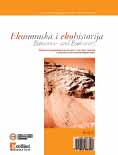»Neodrživi razvoj« ili kako je krčenje šuma u ranome novom vijeku omogućilo širenje Đurđevačkih pijesaka?
»Unsustainable development« or how forest clearing in early modern period enabled desert-like sand of Đurđevac in nordwest Croatia to spread?
Author(s): Hrvoje PetrićSubject(s): History
Published by: Društvo za hrvatsku ekonomsku povijest i ekohistoriju - Izdavačka kuća Meridijani
Keywords: Đurđevečki pijesci (Đurđevac sands); eolian sands in Croatia; early New Era; forest clearing; environmental history; economic history; sustainable development
Summary/Abstract: The paper analyzes ecosystem of research-area (eolian sands) south of River Drava, with epicenter in greater Đurđevac town, northwestern Croatia, nearby the state border with Hungary. The research opens up a question of sustainable or unsustainable development, or rather, does the unearthing of eolian sands (originally covered with humus soil layer) present a case of ecosystem disturbance? After the vegetative planting material (roots) have been removed, eolian sands eroded and resurfaced again. If we take into account that local population »have been cohabiting« with the sands since the Middle Ages, it’s possible to hypothesize, that those attempts at »unearthing sands« probably wasn’t only related to anthropogenous factor and it’s safe to assume that the climate changes had to do with it too. The author leaves a possibility that anthropogenous factors indeed had an influence on change in working the soil (or applying new techniques and new agrarian cultures), forming »bare« (all sand) soil, or rather, its resurface and movement. New reattaching of these »all sand« layers required a lot of effort that people here have applied systematically since the late 19 th century. Local population here planted new plants that quickly adapted to living off sands, one of them particularly important (wattle bark, with large roots spreading in wide diameter, stopping the sands to migrate). These plants enabled creation of humus substrate in the soil. This in fact made the sands soil fertile, and in the 20th century fouling produced forest- and grass vegetation, along with different agricultural species, which finally stopped the sands from further spreading.
Journal: Ekonomska i ekohistorija - Časopis za gospodarsku povijest i povijest okoliša
- Issue Year: 2008
- Issue No: 4
- Page Range: 5-26
- Page Count: 22
- Language: Croatian

